In 2009, the University of Texas officially passed the University of Notre Dame for the most valuable college football program according to Forbes business magazine. In recent years, the Wall Street Journal has been doing their own valuation and coming up with the same results–Texas has a comfortable lead as the No. 1 most valuable team but Notre Dame continues to sit in the No. 2 spot.
Several Big Ten (Ohio State, Michigan) and SEC (Tennessee, LSU, Georgia, Alabama) programs have been consistently among the most valuable in the nation but even without a consistent winning product the Fighting Irish have remained second-best.
Whenever these figures are released each year there’s been a caveat with Notre Dame. No, it’s not that the program refuses to join a conference. It’s that the Irish haven’t fully flexed their muscles in regards the football stadium the way virtually every other major program has over the last 10-15 years.
That’s beginning to change with the unveiling of the Crossroads Project this fall. Here comes advertising on the new jumbotron, am I right!??
Actually, don’t hold your breath on that.
As virtually every Notre Dame fan knows the hallowed grounds on campus inside the football stadium have remained advertising-free since its opening in 1930. Well, almost. The old, old (now going to be the old, old, old) scoreboard was very clearly a nice little advertisement for clock makers Longines. Plus, the school did allow small NBC Sports signage on and around the scoreboard since the network began broadcasting Irish home games in 1991.
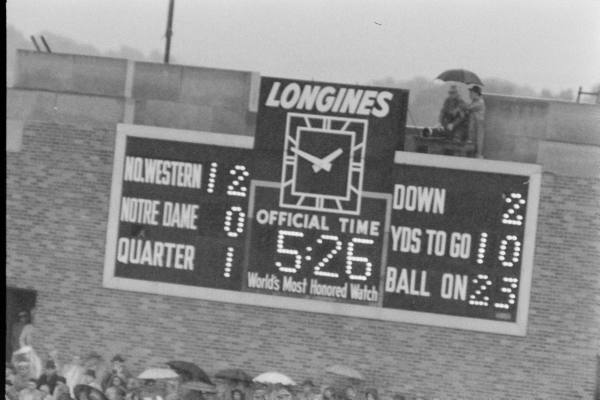
Oh, I guess it IS okay to advertise in the stadium.
We’re approaching 90 years of this tradition–with the university adamant nothing will change with Crossroads–and it’s always surprising at how little faith there is with this topic.
“I’m sorry I’m going to need another 100 years before I believe the school on this one.”
It’s mostly an irrational fear borne out an aversion to change and a misunderstanding of advertising, and more importantly, the operation of video boards and their revenue generation capabilities within the context of Notre Dame’s football budget.
I’m here to explain why Notre Dame will probably never go down the road of in-stadium advertising.
First, let’s talk money. There’s generally a misconception about the revenue that can be generated through advertising during college football games. For example, I’d recommend taking the time to read this lengthy New York Times piece from late 2015 on Alabama’s football team generating wealth for its school. In that article, the NYT discusses the money brought in from ads inside the Tide’s stadium:
Inside Bryant-Denny, the bigger regional and national sponsors own the scoreboards. Regions bank and Toyota pay $80,000 to have their logos rotate down the left side throughout the game. Muscle Milk and Coca-Cola pay six figures to own the tunnels and corner boards. Anywhere from $50,000 to $75,000 buys one minute of pregame ads and two minutes of in-game ads on the LED scroll and attracts companies like Cooper Tires and restaurants like Billy’s Sports Bar.
We can safely assume that these prices are near the top in college football if not Top 5 or Top 3 nationally. Think about it, these advertisers get roughly 600,000 to 700,000 people to see their product for roughly 4 hours per game 6 to 7 times per year. Maybe throw in a little more for a spring game. It’s not super valuable for these schools when juxtaposed with their total revenue.
For the big schools like Alabama, Texas, and Notre Dame you’re looking at maybe an additional 2% to 3% in revenue from this in-stadium advertising. Heck, if you want a more long-term worry it’s stadium naming rights. USC just recently signed a 15-year deal with United Airlines worth $70 million for naming rights at the L.A. Coliseum. Notre Dame could easily earn 600% to 800% more per year from one sponsor on a naming rights deal in comparison to in-stadium advertising and even that large sum hasn’t tempted the university as of yet.
When the Forbes and Wall Street Journals of the world talked about Notre Dame lagging behind it was almost always focused on the lack of premium seating. Obviously, the Crossroads project is rectifying this in the fall.
Notre Dame hasn’t publicly announced any prices for the 3,000 new premium seats (68 loge boxes & 2,100 indoor/outdoor club seats) but the Sports Business Journal recently published a story with insight into the financials involved:
…the new premium seats cost slightly less than Tennessee’s west club seats at Neyland Stadium, the venue where Notre Dame most closely bench-marked its products. Those seats at UT run $5,000 a seat annually, plus capital gifts of $35,000 to $50,000, according to Tennessee athletics’ website.
Now, start plugging some figures into a calculator and it becomes crystal clear why premium seating is so valuable for college football teams and sports franchises in general. In comparison, stadium advertising seems like mere bread crumbs. Which, by the way, is likely why Notre Dame has never forced this on its fans. It’s been a tradition for so long and the extra bit of cash isn’t worth the backlash.
Estimated 800+ square feet of speakers for Notre Dame’s new video board. 🤘🏻🗣🏈 https://t.co/gyxeOjjZ4L
— Eric Murtaugh (@EMMurtaugh) April 26, 2017
There’s also another aspect to this discussion. Notre Dame has altered the stadium stands with the premium seating, a new visitors tunnel, and wider seating to decrease capacity by almost 3,000 seats to 78,000 overall. Even though we’ve recently witnessed some gaudy capacity upgrades (Texas A&M’s Kyle Field famously spent $450 million in upgrades which included an increase of almost 25,000 seats and they backed that down by 4,000 seats the year after its debut season) the truth is that live football is likely slowly headed in the other direction.
I’d be willing to bet that within 50 years the capacity inside Notre Dame Stadium dips below 50,000. For what its worth the L.A. Coliseum–previously well over 100,000 capacity and hovering around 92,000 in recent years–is reducing things to 77,500 following renovations.
This isn’t some new revelatory opinion. Football games in person are brutally long, with little game action, and are becoming a tired and expensive endeavor. It’s just easier, cheaper, and usually flat out better to watch at home. The future of live football is going to be more intimate, catering to a greater percentage of expensive premium seats with a wide variety of amenities, and definitely focused heavily on providing value (food, entertainment, access to technology, etc.) beyond staring at a field for several hours.
If we’re talking about advertising it’s clearly the television fans should be worried about. After all, Notre Dame can’t even get half a million people to show up to the stadium every year for football games while the home finale last year against Virginia Tech (with a poor rating at that) saw 2.4 million people watch just that one contest.
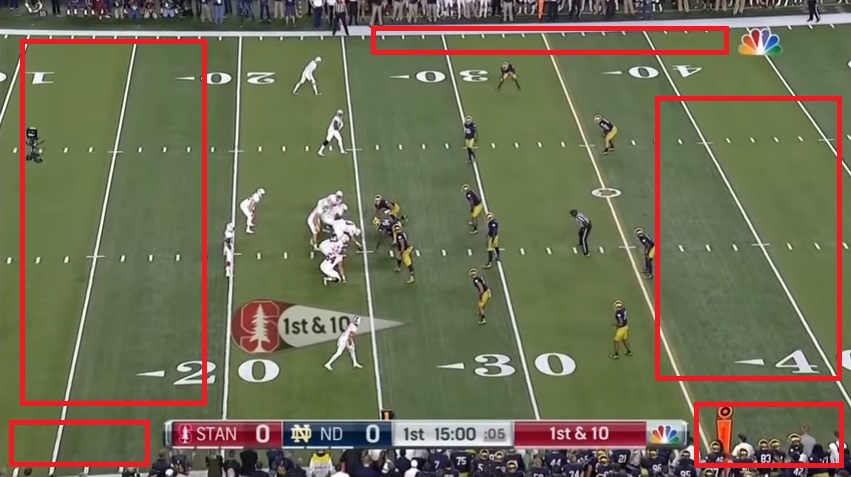
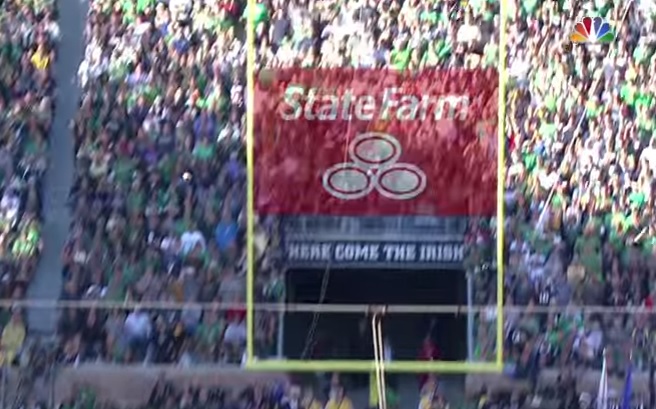
TV ad creep is coming and has already begun.
I’m personally not too worked up about this future of advertising because the market tends to correct the big problems and the implementation is so incremental that we get used to it as the years move forward. Plus, this type of advertising will be so heavily controlled by the likes of ABC, NBC, and ESPN that there’s a sense of inevitability of the networks doing this as traditional cable packages and commercials are slowly eroded.
Top 5 Opinions on Crossroads in the Stadium
1. On many of the Watch ND uploads there is a tiny sponsor that pops up briefly early in the videos. Lately, it’s been the St. Joseph Health System. We’ll presumably see these same videos used on the video board so will it technically be considered in-stadium advertising?
2. I’d bet the use of the video board will draw generally favorable reviews with the exception of the sappy side of the Notre Dame video world. We all know the “What Would You Fight for?” television spot is getting packed into halftime, right? I think the pat-ourselves-on-the-back type of videos (using the board to honor groups, etc.) is going to bring some of the loudest criticism.
3. Despite tin foil hat conspiracies we know the Kiss Cam and 60-second ads for (obligatory reference) Gurley Leep aren’t coming. In addition to the mushy Watch ND videos the loudness, timing, and music used by the sound system will be fascinating to watch unfold. In previous years the acoustics in the stadium were poor but still fairly loud. Now, with a much larger and better sound system the acoustics will be better but also potentially far louder.
4. Don’t sleep on the video ribbon boards being the biggest complaints. These are among the least talked about additions to the entire Crossroads project. Be prepared to hear and read many testimonials about how distracting they are. I’m cautiously optimistic on them, depending on their utilization especially with stats.
5. Notre Dame has given zero indication as of yet but I’d bet they will be expanding Crossroads in the future. People have marveled at the size of the new video board but I was never enamored with the lone board stuck in one end zone. Plus, coming in at 5,184 sq. ft. the Irish board is 13th largest heading into 2017. Not bad but in 5 to 10 years it’ll probably be outside the Top 20 and I fear it’ll be old-fashion a lot quicker than expected. That’s why further building expansion in the corners of the stadium may be in the cards down the line. More places to anchor additional versatile video operations so the current set up doesn’t feel so 1998 in a few years.

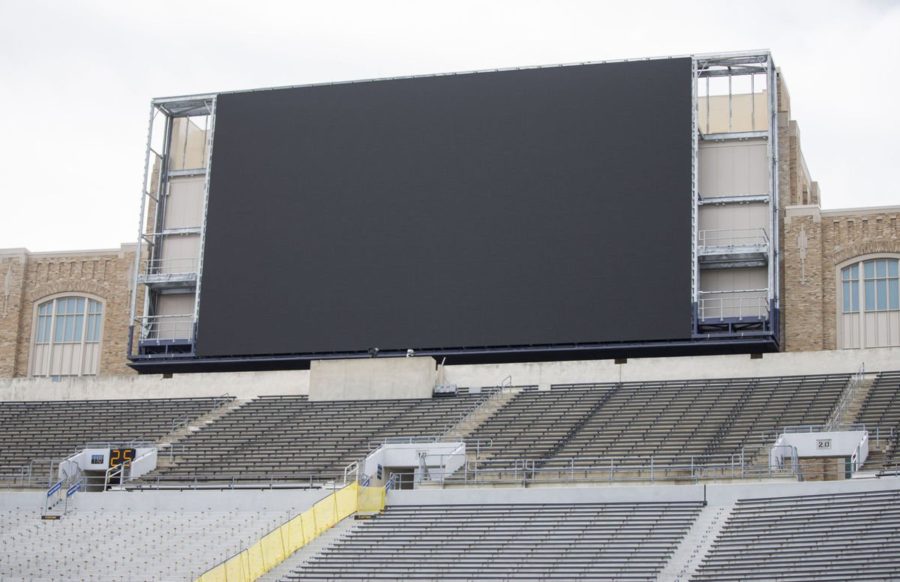
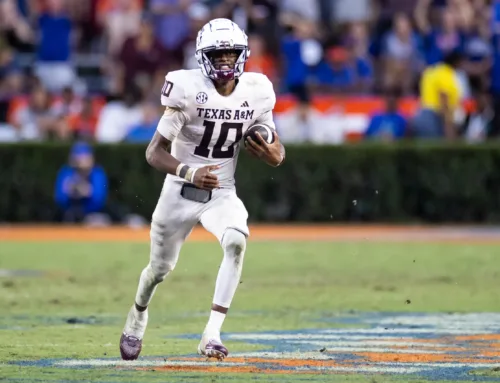


Two thoughts:
1. I don’t see that you addressed the picture about the red boxes on the field. I assume you’re suggesting that ND put ads on the field in these locations? If so, that would be illegal under the NCAA rulebook. Ads are only allowed if stadium naming rights are bought and then only the company’s name is allowed in two places on the field. Logos are banned. For postseason and neutral site games, if a company buys the rights to the game(Meineke Car Care Bowl, Chick-fil-A Iron Bowl, etc) then the company logo can occupy the midfield logo plus two more ads smaller in size can flank that one. Any other commercial logo is banned.
2. WRT the one jumbo tron…I’m going to laugh because I guarantee you in 2-3 years, there will be a portion of the harrumpher crowd complaining that they cant see replays because the jumbotron is at a poor angle to their seats. They’ll start demanding a second one with the fervor they oppose the current renovations.
1. The red boxes are for potential TV ad placement from the networks.
2. I think this will be a legit criticism. Seats in the south end zone, especially the upper bowl are really devalued now.
OK, I misread your intention then. Carry on.
I cannot wait for point #2. I know so many old men in South Bend (my father included) who cannot fathom a way that a jumbotron is going to make the in game experience better. To them, best case scenario, the jumbotron will just malfunction and be off all game, so it can only destroy the tradition of the beautiful untouched stadium (never mind past renovations) that Rockne built.
I’m guessing it might not even take 2 years for them to start whining that they can’t see the replays well enough. That’s going to be fun.
After having watched a goal line stand from the other end zone several times over the years in South Bend, this old man thinks the Jumbotron is a great idea. Perhaps you need to get to know more of us. 😛
“USC just recently signed a 15-year deal with United Airlines worth $70 million for naming rights at the L.A. Coliseum.” And you think the ND ushers are too agressive? Don’t stand up in the front row at United Airlines Stadium for sure.
A few years back I read a Bill Simmons piece about the NFL in which he said they needed to revisit their seating philosophy because it was becoming far too attractive to watch the game at home. Yes, in-person games will always have an “I was there when…” draw, but not every game is interesting enough for that. And now with everyone having big-screen HD TV’s at home, and the HD itself getting better and better, and whatever food and drinks you want to have at a fraction of the in-stadium cost, and all your friends coming over, and throwing the football around in the backyard at halftime…
When I got a crappy, blocky picture on my 25″ tube TV, sure, the in-person experience was exponentially better. Now? I’ve been to NFL games recently, and to be honest I’d much rather stay home. I’m more emotionally attached to Notre Dame, of course, and a visit to campus is much more meaningful than a visit to the Meadowlands, but still – the big money isn’t at the game anymore, even with premium seating. Which, incidentally, the university will sell out with no difficulty year after year. The “just wait til those empty seats embarrass the university!” crowd makes me chuckle.
I must be some kind of weirdo because I don’t make my sports viewing decisions based on how good or bad my literal viewing experience is. I mean, I don’t make this decision like you where “I can see the action up close better from my TV and have better angles, etc.” I go to games to BE at the games. I go for the people watching, the emotion, the ability to revel in success and wallow in failure with my fellow compatriot fans.
I see your point, but fun as celebrating an ND touchdown in the north end zone with my seat-neighbors is, I find it equally irritating when a penalty or review of a play happens in the south red/end zone and the emotion being shared is frustration or confusion.
The video board will go a long way to remedying that, but nothing will change the fact that I live 200 miles from South Bend — and I do realize that many fans travel much much further than me with greater regularity. Being a wheelchair user admittedly adds disproportionately to my sense of inconvenience when it comes to live game attendance.
Nevertheless, I still value the TV viewing experience for the ability to see the action & minutiae of football more clearly while being more able to catch other games the same day, to say nothing of faster, cheaper snack options.
And, let’s be honest, I find it REALLY hard to stay focused on the game without Doug Flutie letting me know what’s up!
I’m to the point that I don’t mind going to a fairly meaningless game (my last one was UMASS in 2015) at ND and watching the big ones from home. Then you can enjoy the atmosphere, not worry about being asked to sit down, or stand in line for the bathroom.
Very comforting points about the nominal value of in-stadium ads, Eric.
And the premium seating? Damn, homie? Just copping those UT numbers, ND is looking at like $15,000,000 in ticket revenue from those seats each season, plus “capital gifts” of, let’s say $40,000 per seat, that’s $120,000,000 per season!
So, conservatively, even taking into account “losing” a few thousand peasant seats, Notre Dame will clear well north of $100,000,000 per season from that luxury seating. That $400 million price tag isn’t looking so bad, especially considering the benefits to the student body and the recruiting benefit of taking kids around a kick-ass new stadium that does retain some vestiges of tradition.
I don’t think it’s quite that much money per season. According to the linked article the capital gift is once every 20 years which significantly reduces the revenue. For this first year yeah it’s probably a very large sum of money as the seats are being purchased for the first time.
However, that $5,000 quoted figure for the seats apparently doesn’t include season ticket prices (add another $2k+) so at minimum every year the school should be getting at least $25 million or so from the premium seats.
It’s like we just signed a second TV deal.
With that kind of up front cash commitment, are we certain those seats are going to sell out each year? I’d also assume some portion of them (I have no idea how many) are going to be used by the University, rather than sold. No idea if we’re talking about a significant enough number to make a dent in that $25 million figure though.
Just talked to a client of mine, lawyer/former judge & ND law grad, who informed me the capital contribution for the suite seating is $100,000.
There are different levels for different sections of the premium seats. If I remember correctly, they don’t actually charge you for the seats. All the money comes from the capital commitment. I think the lowest commitment is around $20k per seat…not sure what the highest is. But, hey, the food and beer are free!
Despite the focus of us fans on the stadium improvements in the Crossroads project, I suspect that they are far from the primary added value of the project from the university’s perspective. As such, I don’t think that the $400 million price tag has been cost-justified by expected revenue increases, or by game revenue in general.
The Crossroads project’s academic building enhancements have increased the educational value of the university. I see that as the primary motivator for making the investment in the first place. The cost of the entire project would probably be justified by the academic buildings alone. The enhancements to the stadium facilities were probably a secondary motivation.
Notre Dame would certainly be capable of underwriting $400 million from their $10 billion endowment fund. Even if they had only raised half the money needed, I feel pretty sure they would have matched it from the fund. If the project were purely an enhancement to the athletic facility, though, I doubt they would put in a nickel.
Great article as always, Eric. Really strong points about ad revenue.
I will say, opinion number 4 about the ribbon boards actually worries me the most. I think while the jumbotron can be a bit much a times (see Gurley Jeeps ads, as you mentioned), ribbon boards draw my eyes away from the action.
I think it has to do with the fact that they are always on and constantly changing. At hockey games you can actually see their reflection on the ice (if your seats are high enough). At least jumbotrons tone it down during the actual play.
That’s very true. Ribbon boards also tend to flash a lot, or transition colors harshly, which can be distracting.
Utilization will be key. Some teams in the NBA go absolutely crazy with their ribbon boards, and their arena video technology in general. I’m most familiar with the Sabres:
https://www.youtube.com/watch?v=lm5zHtISTSc
This video shows a good view of the ribbon for large chunks of a game. I can remember not going to a game for a few years and the ribbon boards suddenly being there and how jarring it was at first. Now, it’s pretty normal for me BUT if you really focus on it it’s rather crazy to watch sometimes.
Almost everything for the Sabres with the ribbon is ad related, especially during play. It also seems to get ‘more busy’ in between whistles. I’ve always wondered if that’s planned, the beginning of ads in the transition being eye-grabbing and then the board settles down more during play.
With no ads, it’ll be interesting to see what they use. The Sabres do have more static “team orientated” ribbons that are used a lot and I’m sure we’ll see plenty of those that use program titles, nicknames, slogans, and logos. We’ll probably see the “Let’s go!” stuff which will probably draw plenty of criticism.
“I’ve always wondered if that’s planned, the beginning of ads in the transition being eye-grabbing and then the board settles down more during play.”
A close friend works in arena operations and as you suspected that is the case. The teams don’t want the ads to be too distracting during the course of play. But you’re certainly right it can be jarring when they transition ads, especially if say one has a mainly black background and it goes to something red or blue, the switch is a little abrupt. I wonder if being outdoors while during the daylight might bring that factor down a little.
I hope they utilize ribbon boards like MLB teams do. You can’t have them flashing or moving too much during the action, as it would be too distracting to hitters. There’s a little more activity from some teams between innings, but for the most part there’s not a ton scrolling across/flashing on them.
I hope they do as much as possible to piss off the harrumphers and start driving those types out of the stadium. Then, maybe we can finally start getting some rabid fans back in there and actually have a real HFA. It’s only been about 30 years since that happened.
Rabid ND fans. Man, that’ll be the day.
Was at reunion this weekend. The stadium looks awesome. Way better than I had expected, and I didn’t expect it to look bad. It looks super Gothic, and someone referred to it as our football castle, which I think was perfect. It looks like a castle with a stadium in the middle of it. Because it was ND stadium, and didn’t look ugly, I never realized just how plain it was.
In general, holy moly has campus grown. There’s got to be close to 50% more buildings than when I graduated in 2007. I am extremely jealous of all the kids just starting their time there.
Noice.
I graduated in ’08 and have had the exact same reaction numerous times. Though, I’m glad Eddy St. Commons & all those condos weren’t there during my time on campus.
Really? I’m 2011, and Eddy St. was pretty fantastic. In fact, I was jealous that I couldn’t afford to live in some of those nicer, newer developments. I really like what they’re doing, both on campus and around it.
Eddy St. is great, but I’d trade it for Club 23 in a heartbeat